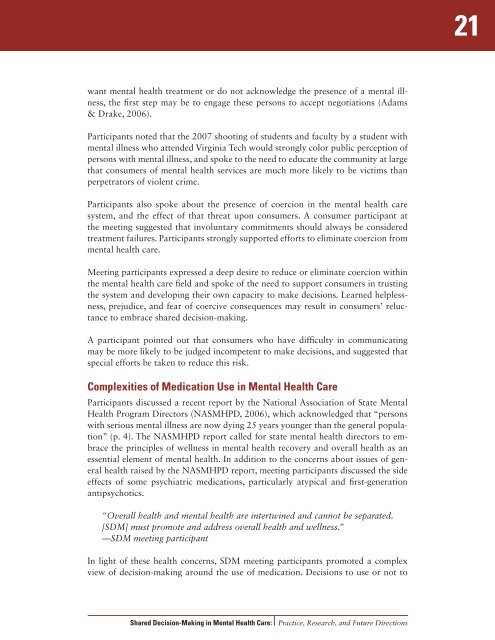Shared Decision-Making in Mental Health Care - SAMHSA Store ...
Shared Decision-Making in Mental Health Care - SAMHSA Store ...
Shared Decision-Making in Mental Health Care - SAMHSA Store ...
You also want an ePaper? Increase the reach of your titles
YUMPU automatically turns print PDFs into web optimized ePapers that Google loves.
21want mental health treatment or do not acknowledge the presence of a mental illness,the first step may be to engage these persons to accept negotiations (Adams& Drake, 2006).Participants noted that the 2007 shoot<strong>in</strong>g of students and faculty by a student withmental illness who attended Virg<strong>in</strong>ia Tech would strongly color public perception ofpersons with mental illness, and spoke to the need to educate the community at largethat consumers of mental health services are much more likely to be victims thanperpetrators of violent crime.Participants also spoke about the presence of coercion <strong>in</strong> the mental health caresystem, and the effect of that threat upon consumers. A consumer participant atthe meet<strong>in</strong>g suggested that <strong>in</strong>voluntary commitments should always be consideredtreatment failures. Participants strongly supported efforts to elim<strong>in</strong>ate coercion frommental health care.Meet<strong>in</strong>g participants expressed a deep desire to reduce or elim<strong>in</strong>ate coercion with<strong>in</strong>the mental health care field and spoke of the need to support consumers <strong>in</strong> trust<strong>in</strong>gthe system and develop<strong>in</strong>g their own capacity to make decisions. Learned helplessness,prejudice, and fear of coercive consequences may result <strong>in</strong> consumers’ reluctanceto embrace shared decision-mak<strong>in</strong>g.A participant po<strong>in</strong>ted out that consumers who have difficulty <strong>in</strong> communicat<strong>in</strong>gmay be more likely to be judged <strong>in</strong>competent to make decisions, and suggested thatspecial efforts be taken to reduce this risk.Complexities of Medication Use <strong>in</strong> <strong>Mental</strong> <strong>Health</strong> <strong>Care</strong>Participants discussed a recent report by the National Association of State <strong>Mental</strong><strong>Health</strong> Program Directors (NASMHPD, 2006), which acknowledged that “personswith serious mental illness are now dy<strong>in</strong>g 25 years younger than the general population”(p. 4). The NASMHPD report called for state mental health directors to embracethe pr<strong>in</strong>ciples of wellness <strong>in</strong> mental health recovery and overall health as anessential element of mental health. In addition to the concerns about issues of generalhealth raised by the NASMHPD report, meet<strong>in</strong>g participants discussed the sideeffects of some psychiatric medications, particularly atypical and first-generationantipsychotics.“Overall health and mental health are <strong>in</strong>tertw<strong>in</strong>ed and cannot be separated.[SDM] must promote and address overall health and wellness.”—SDM meet<strong>in</strong>g participantIn light of these health concerns, SDM meet<strong>in</strong>g participants promoted a complexview of decision-mak<strong>in</strong>g around the use of medication. <strong>Decision</strong>s to use or not to<strong>Shared</strong> <strong>Decision</strong>-<strong>Mak<strong>in</strong>g</strong> <strong>in</strong> <strong>Mental</strong> <strong>Health</strong> <strong>Care</strong>:Practice, Research, and Future Directions
















